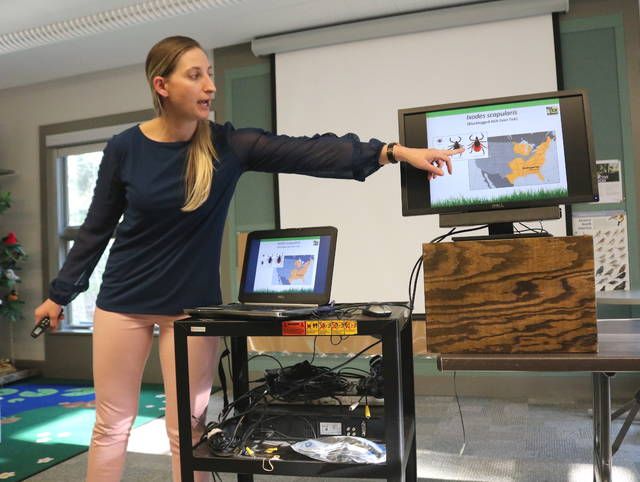Click here to subscribe today or Login.
BUTLER TWP. — As the weather improves and more people spend more time outdoors, they become more susceptible to tick-borne diseases like Lyme disease, an expert explained Tuesday.
According to the state Department of Health, Pennsylvania has led the nation in confirmed cases of Lyme disease for the past several years. Researchers from the Department of Environmental Protection also found evidence of deer ticks in all 67 counties.
“Out of all the cases, we make up 33 percent of the total Lyme disease cases in the United States, so we have a really big issue with Lyme disease in Pennsylvania,” said Nicole Chinnici, director of East Stroudsburg University’s Northeast Wildlife DNA Laboratory. The facility is currently the largest tick-testing research site in the state.
Lyme disease is caused by the bacterium Borrelia burgdorferi and is often transmitted through the bite of an infected black legged tick, also known as a deer tick. According to data collected by the Department of Health’s Bureau of Communicable Diseases, 168 cases of Lyme disease were found in Luzerne County in 2016.
Protection tips
A presentation was held Tuesday evening at Nescopeck State Park on how to prevent tick bites and Lyme disease.
Chinnici said ticks usually live in areas with lots of wildlife or in tall grass, forest edges, the bases of trees, thick brush, and anywhere it is shaded with high humidity.
To avoid ticks:
• Spray skin with insect repellent.
• Spray socks, shoes, and other clothing as well as camping gear, picnic blankets, and backpacks with Permetherin, a man-made chemical produced by the chrysanthemum flower. It repels and kills ticks upon contact, but do not let it touch the skin.
•Wear light-colored clothing to see ticks more easily.
• Wear a hat, long sleeves, and enclosed shoes.
After spending time in an area where ticks are common, Chinnici advised following a routine to ensure that no ticks are brought inside the home:
• Remove clothes and shoes immediately.
• Put clothes in dryer in high heat for at least 10 minutes, because the high temperature will kill any ticks clinging to clothing
• Shower within two hours of potential exposure to wash off any loose ticks, especially in the hair.
If a tick is found on the body, Chinnici advised to grab the tick as close to the skin as possible with blunt angled tweezers and pull it straight up and out. After removing the tick, disinfect the bite area, the tweezers, and hands using rubbing alcohol, an iodine, scrub, or germicidal soap and water.
Chinnici emphasized the “number one” sign of Lyme disease is fatigue. “If you feel like you are completely exhausted to the point that you cannot get out of bed, that is the symptom that I tell people to think about with Lyme disease,” she said.
Fever, chills and flu-like symptoms as well as nausea and achy joints are also associated with Lyme disease. Multiple rashes varying in size as well as a “bull’s eye” rash, which has a dark center with a ring around it, are also common after getting a tick bite. Chinnici said that medical attention should be sought if any of these signs and symptoms are detected.





